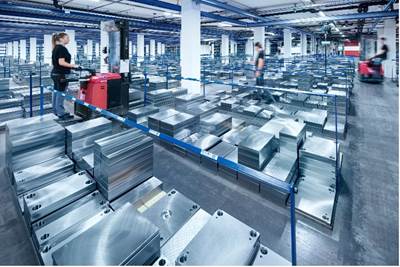What Does Ukraine War Have to Do with Plastics?
Europe is feeling the heat from the abrupt halt to steel exports from Russia and Ukraine. Will the ripples reach to our shores, and when?

Meusburger’s mold plate warehouse is well stocked and isn’t supplied from Russia or Ukraine. But the company is not immune to the current price squeeze from tight supplies in Europe. (Photo: Meusburger)
It’s not just about spiking oil and natural gas prices and their effect on plastic resin tabs. As an essay in Bloomberg Opinion puts it, “Steel is the other big commodity shock from Russia’s invasion.” According to that report, Russia and Ukraine together make up the world’s second-largest steel exporter (after China), and both of them halted steel exports after the war began. One of the largest steel plants in Europe, near Mariupol in Ukraine, was damaged by bombs or missiles. The ripple effects of all that are being felt by producers of plastic mold components, at least in Europe.
I was tipped off to this by a notice from Meusburger, a German supplier of mold components with U.S. operations in Mint Hill, N.C. According to the German announcement, “The current crisis in Ukraine is having a drastic effect on the steel market. The acute shortage of raw materials has caused great uncertainty and an extreme rise in prices.”
Meusburger wanted to reassure its customers because it does not purchase any goods from Russia or Ukraine and has long-standing supply partnerships and a large warehouse, so it is “optimally positioned to guarantee high supply security in these uncertain times.” However, Meusburger “can’t avoid buying steel and must accept the increased costs.”
So far, I’ve not been able to confirm any perturbations of the mold steel business here in the U.S. attributable to the Ukraine conflict. But, as noted by my colleague, Christina Fuges, chief editor of sister publication MoldMaking Technology, there have been price increases related to supply-chain issues, including tariffs and quotas on imported metals.
And, as noted by Meusburger, steel production uses a lot of energy from natural gas, whose U.S. price has been on the way up—a trend not likely to reverse soon, in my opinion.
The U.S. may not yet have been directly affected. Yet in a global market, the question is not so much if, but when.
Brenda Clark, engineering manager for Hasco America in Fletcher, N.C., says her company imports most of its mold steel but is currently insulated from the effects of the Ukraine war. “We have an adequate supply of mold plates in stock,” she says, “4000 plates in the U.S., 3000 in Canada and 7000 plates in Mexico. So we’re not worried.” However, Clark concedes that steel is a global commodity, like oil, and a squeeze in one geographic region may be felt—eventually—in others. “It all depends on how long this goes on.”
Ed Walsh, job-processing and shop-floor manager for Westminster Tool in Plainfield, Conn., says he has seen an incremental increase in steel costs but no issues of supply or delivery time. He has not noticed a dramatic spike in cost associated with the war and mentioned that “all of our supply costs have increased steadily over the last six months.”
I can only recommend that molders be alert and keep in close touch with your suppliers of tooling and mold components to anticipate what may be coming.
Related Content
Hot Runners: A View from the Bottom Up
Addressing hot-runner benefits, improvements, and everyday issues from the perspective of decades of experience with probably every brand on the market. Part 1 of 2.
Read MoreBest Methods of Molding Undercuts
Producing plastics parts with undercuts presents distinct challenges for molders.
Read MoreHow to Start a Hot-Runner Mold That Has No Tip Insulators
Here's a method to assist with efficient dark-to-light color changes on hot-runner systems that are hot-tipped.
Read MoreImprove The Cooling Performance Of Your Molds
Need to figure out your mold-cooling energy requirements for the various polymers you run? What about sizing cooling circuits so they provide adequate cooling capacity? Learn the tricks of the trade here.
Read MoreRead Next
Meusburger Guarantees Continuous Delivery in Midst of Broader Supply Crunch
In the midst of a raw material crisis, the company says its 100% in-house production of plates and deep material inventory will help it weather the difficult times.
Read MoreUnderstanding Melting in Single-Screw Extruders
You can better visualize the melting process by “flipping” the observation point so that the barrel appears to be turning clockwise around a stationary screw.
Read MoreAdvanced Recycling: Beyond Pyrolysis
Consumer-product brand owners increasingly see advanced chemical recycling as a necessary complement to mechanical recycling if they are to meet ambitious goals for a circular economy in the next decade. Dozens of technology providers are developing new technologies to overcome the limitations of existing pyrolysis methods and to commercialize various alternative approaches to chemical recycling of plastics.
Read More


























